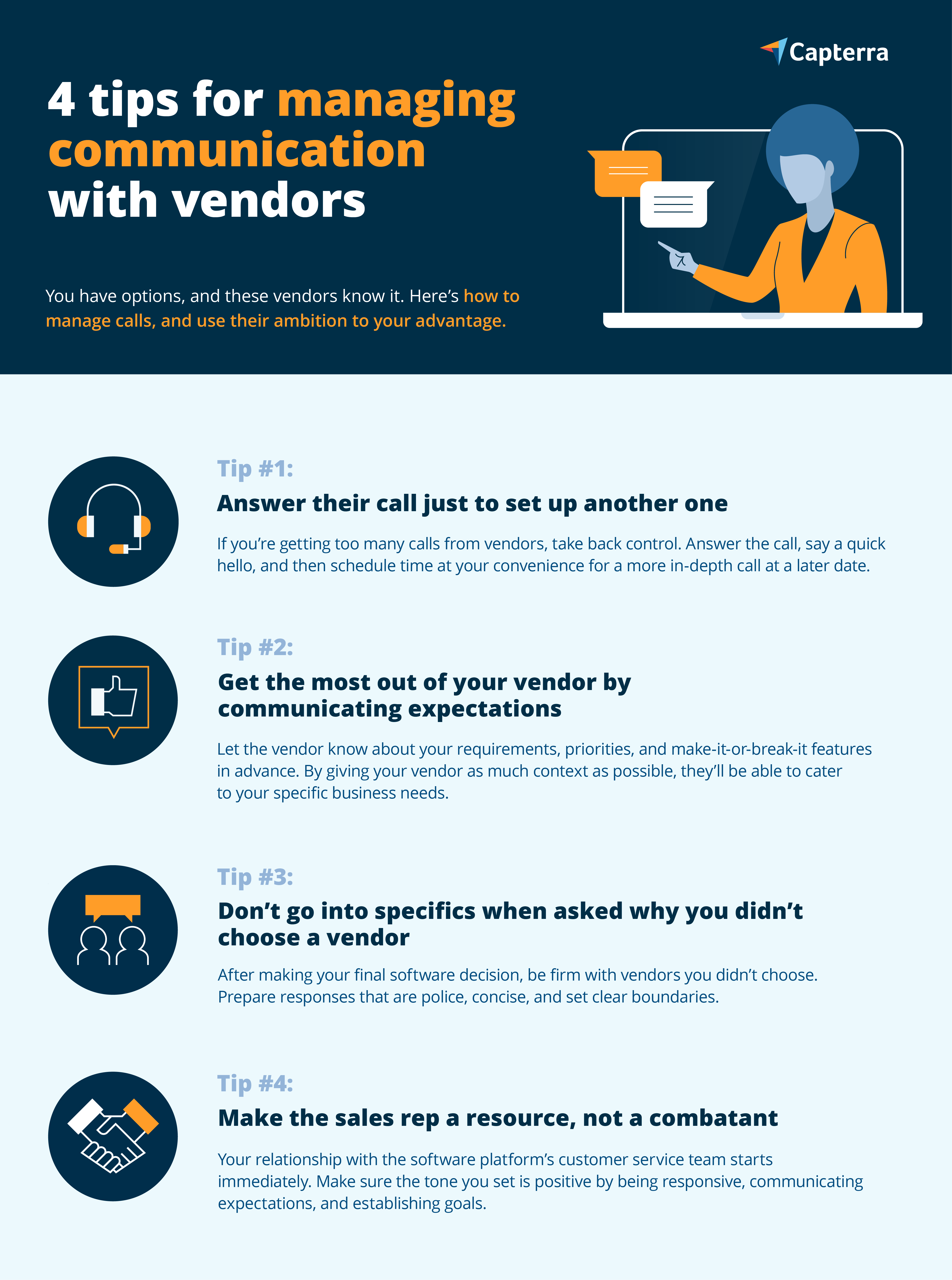Stay in control of your software search by managing expectations and communication with vendors at every step.
Reaching out to vendors is a big step in the software buying journey—it means you’ve already done the initial legwork of the selection process: well done!
And you’ve probably already noticed that the software selection process can be overwhelming when not handled correctly. First, you had to identify your business challenge, then define your software requirements, and finally, wade through all the vendor options to create the shortlist of options in front of you.
Now you’re ready to start talking with vendors and see product demos, which will bring its own unique challenges. And this stage will be largely defined by how you manage expectations and communication with vendors.
If you’re a small-business leader undergoing the software selection process, we want you to have the best possible vendor experience. Here are a few tips for how you can streamline communication and take control of the process.

4 tips for managing communication with vendors
According to Capterra’s 2023 SMB Software Buying Trends Survey*, most small businesses consider four to six vendors before making a final software purchase. By weighing your options, you’ll be able to make a fully informed decision that will set your business up for success.
Salespeople are aware they’re not your only option, and their goal is to sign you before someone else does. As a result, they will be eager to talk to you. In fact, they may be so eager to talk to you, that you may feel like they are calling a little too much.
While we can’t change this practice, we can help you manage those calls and use their ambition to your advantage.
Tip #1: Answer their call simply to set up another one
One of the reasons sales calls become so frequent is because salespeople aren’t able to reach anyone. It is common practice to give pricing quotes over the phone rather than by email, and they want to be responsive to your interest and follow-up on previous conversations. As a result, they will likely keep calling until they can schedule time with you.
If these calls feel overwhelming, remember that you’re in control of the process. Answer the call, say a quick hello, and then schedule time at your convenience for a more in-depth call at a later date.
This ensures that you’re in control of the pace and gives you the time you and your team need to prepare questions.
Tip #2: Get the most out of your vendor by communicating expectations
Software platforms tend to be versatile, offering many features that are used in different ways across industries. You want to make sure that the call you have with the vendor is tailored specifically to your business’s needs.
Prepare for your scheduled demo by letting the vendor know about your requirements, priorities, and make-it-or-break-it features in advance. Be sure to also inquire about things such as total cost, training and support options, software integrations, and data security measures.
Ask them to review these notes before the call and request a personalized demo that presents use cases most relevant to your business.
By giving your vendor as much context as possible, you both will get the most out of the demo, and you’ll be able to walk away feeling like you have the information you need to make a decision.
Tip #3: Don’t go into specifics when asked why you didn’t choose a vendor
You’ll only choose one vendor, and when you make your choice, you’ll have to let the others know that you decided to go in a different direction. The vendors you don’t select will likely ask for feedback on why you didn’t choose them.
This creates an opening for them to try to win you back and might lead to more unwanted phone calls and emails. Prepare responses that are polite but concise:
“We just felt more comfortable about the overall value of another vendor and have chosen to use them going forward."
“While you have a competitive product, there was not a singular factor that caused us to choose the other company over yours. We had to look at the entire offering, and they just won out this time.”
These responses are polite, keeping bridges intact, but they also clearly convey the message that you’ve made your decision, leaving no room for interpretation.
Tip #4: Make the sales rep a resource, not a combatant
When you commit to a software, you don’t only get access to the platform and a set of features, but also a relationship with the service provider. And this relationship begins immediately.
Your first point of contact with the vendor will likely be the sales representative, and the tone you set at the demo stage can impact the relationship moving forward. To make sure it’s a good one, be responsive, establish goals, and be clear about your expectations.
How you treat the sales rep and what you communicate to them may carry over to the customer service team, should you decide to invest in the vendor’s platform. When this happens, your sales rep will likely share information about you (such as business and industry details, concerns, goals, and their experience working with you so far) with the customer service team.
Having a good relationship with the customer service team may make solving challenges, such as getting the new platform integrated with other software you use, training employees, and any future setbacks you face with the platform, just that much smoother.
Set boundaries to maintain control over the software buying process
Stay in control of your software search by managing expectations at every step. Whether it’s taking charge of setting the schedule, crafting neutral responses, or being clear and proactive about your goals and expectations, these steps can help remove the chaos of your relationship with vendors.
Capterra has a ton of resources to help you prepare such as software selection checklists, demo preparation, and pitfalls to avoid.
